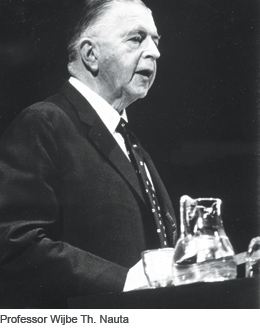 Till the sixties of the previous century receptors were a mere concept, a metaphor: a lock with fitting keys, agonists and antagonists. In The Netherlands the pharmacologist Ariëns (Nijmegen) studied properties of the unknown receptors, introduced concepts like intrinsic activity and partial agonism “without knowing”- as he admitted- anything about the nature of receptors at all”. In Amsterdam (VU University) the (pharmaco)chemist Nauta was especially interested in the keys, ligands of the receptors. Wijbe Nauta who had selected the histaminergic systems for his research on receptors, has been very instrumental for the acceptance of medicinal chemistry as an independent chemical discipline, but he had good reasons to prefer the term pharmacochemisty over medicinal chemistry though. He played a major role in starting the section Pharmacochemistry of the Royal Netherlands Chemical Society and was one of the founders of the European Federation for Medicinal Chemistry, EFMC.
Till the sixties of the previous century receptors were a mere concept, a metaphor: a lock with fitting keys, agonists and antagonists. In The Netherlands the pharmacologist Ariëns (Nijmegen) studied properties of the unknown receptors, introduced concepts like intrinsic activity and partial agonism “without knowing”- as he admitted- anything about the nature of receptors at all”. In Amsterdam (VU University) the (pharmaco)chemist Nauta was especially interested in the keys, ligands of the receptors. Wijbe Nauta who had selected the histaminergic systems for his research on receptors, has been very instrumental for the acceptance of medicinal chemistry as an independent chemical discipline, but he had good reasons to prefer the term pharmacochemisty over medicinal chemistry though. He played a major role in starting the section Pharmacochemistry of the Royal Netherlands Chemical Society and was one of the founders of the European Federation for Medicinal Chemistry, EFMC.
One of the most prominent results of Nauta’s investigations of histaminergic (H1) ligands was his proposition that receptors might be proteins in a helix shape. The paper on this idea- there was not any proof - is likely the first one in which the receptor is considered to be a protein, an idea which later on showed to be quite correct.
After the death of Wijbe Nauta (1913- 1986) the “Nauta Foundation” was created. This foundation finances since 1992 the in the mean time prestigious Nauta Award of the EFMC (every second year), advanced courses in the field and an extraordinary chair (med. chem.) at the VU University. To mark the 100th anniversary of the birthday of its name giver the foundation and the Division Medicinal Chemistry of the VU University organized on 24-25 June 2013 a symposium in Amsterdam. Awardees of the priz(AW), course organizers (CO) presented inspiring lectures on medicinal chemistry as an interdisciplinary, integrated science: perspectives with a bit of history and nostalgia. The symposium was the stage of the first scientific meeting of the COST Action Glisten (CM1207) a European scientific network in the area of G-protein coupled receptors, GPCRs. Prominent GPCR researchers showed how new insights in GPCR structures can be used to discover new biologically active ligands and to improve the understanding of the physiological function of these “fertilizers of medicinal chemistry”.
The Nauta session at the first day of the symposium were chaired by Povl Krogsgard Laarsen and Robin Ganellin, both awardee of the prize. (AW and CO!) presented his views on chances and challenges for medicinal chemists were discussed. Some of these challenges include consideration of the biochemistry of drug metabolism (Bernard Testa, AW) and (epi)genetic control of drug treatment efficacy (Magnus Ingelman-Sundberg, CO). The successful discovery of a CFTR potentiator for the treatment of cystic fibrosis (Peter Grootenhuis, CO) illustrated the potential impact of medicinal chemistry. The scientific progress in G-protein coupled receptor (GPCR) research through the ages (Alex Levitzki, AW) as fertilizers of medicinal chemistry was illustrated by the design and synthesis of ligands that target spinal MOPR-mGluR5 heteromers for the treatment of intractable inflammatory pain (Philip Portoghese, AW), the design and synthesis of diverse histamine H4 ligands to increase understanding of GPCR-ligand interactions (Eric Haaksma, Nauta chair), and the development of ligands to validate the role of receptors for long chain fatty acids in the treatment of type II diabetes (Graeme Milligan, CO). Medicinal chemistry can play an important role in the deorphanization of GPCRs (Hans Bräuner-Osborne), and the experimental and virtual screening for small, fragment-like GPCR ligands (Gyorgy Keserü), and investigation of allosteric GPCR modulation (Nuska Tschammer) are interesting new research areas. The highly successful meeting was attended by over 100 scientists, and included a speakers’ dinner in a famous old house (Felix Meritis) at one of the canals in Amsterdam. At the dinner Gert Folkerts (CO) presented an intriguing speech on ”reproducibility in science”.
Several other new breakthroughs in GPCR research were covered on the second day of the symposium, including computational approaches to discover new GPCR ligands. The speakers showed how in silico approaches can be developed to predict GPCR-ligand interactions (Chris de Graaf), to identify selective ligands from docking to GPCR x-ray structures and homology models (Peter Kolb), and to give new insights into the molecular determinants of GPCR ligand promiscuity (Masha Niv). In combination with the developments in GPCR structural biology, computational tools offer new approaches for GPCR modulation (Leonardo Pardo) and are part of the new wave in GPCR structure-based drug design (Jonathan Mason). The final session showed how the new GPCR structures, crystallized by novel nanobodies (Jan Steyaert), thermostabilizing mutations (Chris Tate), and fusion protein technologies, increase our understanding of GPCR function, ligand efficacy, and receptor activation. Interestingly, the symposium provided the first glimpse of the first crystal structures of the transmembrane domain of class B GPCRs, the glucagon receptor (De Graaf, Katritch) and corticotropin-releasing factor receptor 1 (Mason). The new era of GPCR structural biology enables the identification of molecular signatures of GPCRs (Gebhard Schertler) that offer structural insights into the function and pharmacology of the GPCR superfamily (Vsevolod (Seva) Katritch).
For more information please see also:
www.nautastichting.nl
www.medchemsymposium.org
www.glisten-gpcr.eu
By Henk Timmerman









